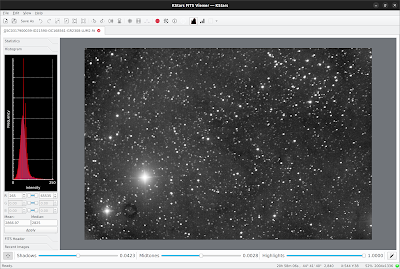I wanted to do a test shot inside the North American Nebula (aka NGC 7000).
In particular, I wanted to see if the token star would work. Will it serve as the anchoring start for all the shots in the mosaic of 24 panels?
And I wanted to check the offsetting from the token star, horizontal -35, vertical 0, to gauge if all the panels will align well.
Initially, I tried to use HIP 103519 as the anchor but the robot protested. Selected star GSC 03179 00039 instead. Not too bright. And actually a bit better, I hope, for aligning the mosaic.
To the Ubuntu workstation, I downloaded the zip archive with luminance, hydrogen α, and ionised oxygen shots.
Downloaded FITS Liberator 4 deb archive from the NOIRLab site and installed it, per their instructions. But it crashed when I loaded any of the files. I'll have to but the Thinkin' Cap on to figure out that issue...
Tried double-clicking a file in the Files app and was surprised to see KStars program launch. OK. It works. I'll take it.
The Clear Sky Chart showed below average transparency at the time. There appear to be registration problems (or there are a lot of double stars in the area). There's also a sharp dust donut at the bottom left.
North is up and east is left.
The extremely bright star in the field is HR 8035.
The clustering of bright stars near the top right of the frame is actually an open cluster within the nebula: NGC 6997 (aka H VIII-58).
Lots of magnitude 18 stars in the field.
SkyTools 4 Visual Pro also identifies LDN 935 in the area. I believe this is the dark region in the NA nebula that is normally considered the Gulf of Mexico.
I believe the -35 offset is a bit too much. Maybe I'll try -30 or -25. The vertical looks perfect.



No comments:
Post a Comment